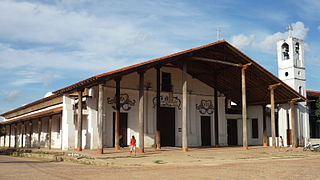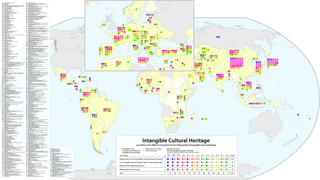
The Day of the Dead is a holiday traditionally celebrated on November 1 and 2, though other days, such as October 31 or November 6, may be included depending on the locality. It is widely observed in Mexico, where it largely developed, and is also observed in other places, especially by people of Mexican heritage. The observance falls during the Christian period of Allhallowtide. Some argue that there are Indigenous Mexican or ancient Aztec influences that account for the custom, and it has become a way to remember those forebears of Mexican culture. The Day of the Dead is largely seen as having a festive characteristic. The multi-day holiday involves family and friends gathering to pay respects and to remember friends and family members who have died. These celebrations can take a humorous tone, as celebrants remember funny events and anecdotes about the departed.

The Jesuit missions among the Guaraní were a type of settlement for the Guaraní people in an area straddling the borders of present-day Argentina, Brazil and Paraguay. The missions were established by the Jesuit Order of the Catholic Church early in the 17th century and ended in the late 18th century after the expulsion of the Jesuit order from the Americas. The missions have been called an experiment in "socialist theocracy" or a rare example of "benign colonialism". Others have argued that "the Jesuits took away the Indians' freedom, forced them to radically change their lifestyle, physically abused them, and subjected them to disease".

Tourism in Mexico is a very important industry. Since the 1960s, it has been heavily promoted by the Mexican government as "an industry without smokestacks". Mexico has traditionally been among the most visited countries in the world according to the World Tourism Organization, and it is the second-most visited country in the Americas, after the United States. In 2017, Mexico was ranked as the sixth-most visited country in the world for tourism activities. Mexico has a significant number of UNESCO World Heritage Sites, with the list including ancient ruins, colonial cities, and natural reserves, as well as a number of works of modern public and private architecture. Mexico has attracted foreign visitors beginning in the early nineteenth century, with its cultural festivals, colonial cities, nature reserves and the beach resorts. The nation's temperate climate and unique culture – a fusion of the European and the Mesoamerican – are attractive to tourists. The peak tourism seasons in the country are during December and the mid-Summer, with brief surges during the week before Easter and Spring break, when many of the beach resort sites become popular destinations for college students from the United States.

Culture of Nicaragua has many influences. The western part was colonized by the Spanish and its culture is similar to that of other Hispanic countries. The inhabitants of western Nicaragua are mostly triracial(Indigenous, West African, European) and the main language is invariably Spanish.

San Miguel de Allende is the principal city in the municipality of San Miguel de Allende, located in the far eastern part of Guanajuato, Mexico. A part of the Bajío region, the city lies 274 km (170 mi) from Mexico City, 86 km (53 mi) from Querétaro, and 97 km (60 mi) from the state capital of Guanajuato. The city's name derives from two persons: 16th-century friar Juan de San Miguel, and a martyr of Mexican Independence, Ignacio Allende, who was born in a house facing the city's central plaza. San Miguel de Allende was also a critical epicenter during the historic Chichimeca War (1540–1590) when the Chichimeca held back the Spanish Empire during the initial phases of European colonization. Today, an old section of the town is part of a proclaimed World Heritage Site, attracting thousands of tourists and new residents from abroad every year.

Bumba Meu Boi is an interactive play celebrated in Brazil. It originated in the 18th century. It is a form of social criticism. Lower class Brazilians mock and criticize those of higher social status through a comedic Folklore story told in song and dance. Though not as well known internationally as Carnival and other Brazilian festivals, it is older and deeply rooted in the culture of Brazil. The tale can vary depending on the region and social setting at which it is practiced. However, its essential theme remains the same, with a focus on the death and resurrection of an ox.

Trinidad, officially La Santísima Trinidad, is a city in Bolivia, capital of the department of Beni. The population is 130,000. While historically a peripheral city in Bolivia, Trinidad is today an important center for the Bolivian Bovine industry and has enjoyed a modest economic boom in recent years and enjoys an HDI index of above 0.700.
Moxos is a province in the Beni Department, Bolivia. It is named after the Moxos savanna.

The Inti Raymi is a traditional religious ceremony of the Inca Empire in honor of the god Inti, the most venerated deity in Inca religion. It was the celebration of the winter solstice – the shortest day of the year in terms of the time between sunrise and sunset – and the Inca New Year, when the hours of light would begin to lengthen again. In territories south of the equator, the Gregorian months of June and July are winter months. It is held on June 24.

The Guelaguetza, or Los lunes del cerro, is an annual indigenous cultural event in Mexico that takes place in the city of Oaxaca, capital of the state of Oaxaca, and nearby villages. The celebration features traditional costumed dancing by gender-separated groups. It includes parades of indigenous walking bands, native food, and statewide artisanal crafts, such as pre-Hispanic style textiles. Each costume, or traje, and dance usually has a local indigenous historical and cultural meaning. While the celebration has attracted an increasing number of tourists, it is primarily one of deep cultural importance for the indigenous peoples of the state and is important for the survival of these cultures.

The Mojeños, also known as Moxeños, Moxos, or Mojos, are an indigenous people of Bolivia. They live in south central Beni Department, on both banks of the Mamore River, and on the marshy plains to its west, known as the Llanos de Mojos. The Mamore is a tributary to the Madeira River in northern Bolivia.

Quyllurit'i or Qoyllur Rit'i is a syncretic religious festival held annually at the Sinakara Valley in the southern highlands Cusco Region of Peru. Local indigenous people of the Andes know this festival as a native celebration of the stars. In particular they celebrate the reappearance of the Pleiades constellation, known in Quechua as Qullqa, or "storehouse," and associated with the upcoming harvest and New Year. The Pleiades disappears from view in April and reappears in June. The new year is marked by indigenous people of the Southern Hemisphere on the Winter Solstice in June, and it is also a Catholic festival. The people have celebrated this period of time for hundreds if not thousands of years. The pilgrimage and associated festival was inscribed in 2011 on the UNESCO Intangible Cultural Heritage Lists.

San Ignacio de Moxos is a town in the Beni Department of northern Bolivia.
Moxo is any of the Arawakan languages spoken by the Moxo people of the Llanos de Moxos in northeastern Bolivia. The two extant languages of the Moxo people, Trinitario and Ignaciano, are as distinct from one another as they are from neighboring Arawakan languages. The extinct Magiana was also distinct.

The Jesuit Missions of Chiquitos are located in Santa Cruz department in eastern Bolivia. Six of these former missions collectively were designated as a UNESCO World Heritage Site in 1990. Distinguished by a unique fusion of European and Amerindian cultural influences, the missions were founded as reductions or reducciones de indios by Jesuits in the 17th and 18th centuries to convert local tribes to Christianity.

UNESCO established its Lists of Intangible Cultural Heritage with the aim of ensuring better protection of important intangible cultural heritages worldwide and the awareness of their significance. This list is published by the Intergovernmental Committee for the Safeguarding of Intangible Cultural Heritage, the members of which are elected by State Parties meeting in a General Assembly. Through a compendium of the different oral and intangible treasures of humankind worldwide, the programme aims to draw attention to the importance of safeguarding intangible heritage, which UNESCO has identified as an essential component and as a repository of cultural diversity and of creative expression.

The Villa Tunari – San Ignacio de Moxos Highway, also known as the Cochabamba–Beni Highway is a road project in Bolivia connecting the towns of Villa Tunari and San Ignacio de Moxos. It would provide the first direct highway link between the two departments. The project has an expected overall cost of $415 million and extends 306 kilometres (190 mi), divided into three segments: Segment I from Villa Tunari to Isinuta, Segment II from Isinuta to Monte Grande, and Segment III from Monte Grande to San Ignacio de Moxos. Opposition to the highway by local indigenous communities, environmentalists, as well as shifting relations between the Bolivian government and the project's builders and funders interrupted construction of Segment I from October 2011 until October 2013, indefinitely delayed Segment II, and postponed construction of Segment III until June 2015. Segment II will proceed after the government has promised to raise living standards in the area.
This is a list of notable events relating to the environment in 2011. They relate to environmental law, conservation, environmentalism and environmental issues.

Folk dance of Mexico, commonly known as baile folklorico or Mexican ballet folk dance, is a term used to collectively describe traditional Mexican folk dances. Ballet folklórico is not just one type of dance, it encompasses each region's traditional dance that has been influenced by their local folklore and has been entwined with ballet characteristics to be made into a theatrical production. Each dance represents a different region in Mexico illustrated through their different zapateado, footwork, having differing stomps or heel toe points, and choreography that imitates animals from their region such as horses, iguanas, and vultures.

The Jesuit Missions of Moxos are located in the Llanos de Moxos of Beni department in eastern Bolivia. Distinguished by a unique fusion of European and Amerindian cultural influences, the missions were founded as reductions or reducciones de indios by Jesuits in the 17th and 18th centuries to convert local tribes to Christianity.

















